Asus UX564EH, Q538EI, UX564PH, Q528EH User’s Manual

E17801
Revised Edition V2 / December 2020
E-Manual

COPYRIGHT INFORMATION
No part of this manual, including the products and software described in it, may be reproduced, transmitted, transcribed, stored in a retrieval system, or translated into any language in any form or by any means, except documentation kept by the purchaser for backup purposes, without the express written permission of ASUSTeK COMPUTER INC. (“ASUS”).
ASUS PROVIDES THIS MANUAL “AS IS”WITHOUT WARRANTY OF ANY KIND, EITHER EXPRESS OR IMPLIED, INCLUDING BUT NOT LIMITED TO THE IMPLIED WARRANTIES OR CONDITIONS OF MERCHANTABILITY OR FITNESS FOR A PARTICULAR PURPOSE. IN NO EVENT SHALL ASUS, ITS DIRECTORS, OFFICERS, EMPLOYEES OR AGENTS BE LIABLE FOR ANY INDIRECT, SPECIAL, INCIDENTAL, OR CONSEQUENTIAL DAMAGES (INCLUDING DAMAGES FOR LOSS OF PROFITS, LOSS OF BUSINESS, LOSS OF USE OR DATA, INTERRUPTION OF BUSINESS AND THE LIKE), EVEN IF ASUS HAS BEEN ADVISED OF THE POSSIBILITY OF SUCH DAMAGES ARISING FROM ANY DEFECT OR ERROR IN THIS MANUAL OR PRODUCT.
Products and corporate names appearing in this manual may or may not be registered trademarks or copyrights of their respective companies, and are used only for identification or explanation and to the owners’ benefit, without intent to infringe.
SPECIFICATIONS AND INFORMATION CONTAINED IN THIS MANUAL ARE FURNISHED FOR INFORMATIONAL USE ONLY, AND ARE SUBJECT TO CHANGE AT ANY TIME WITHOUT NOTICE, AND SHOULD NOT BE CONSTRUED AS A COMMITMENT BY ASUS. ASUS ASSUMES NO RESPONSIBILITY OR LIABILITY FOR ANY ERRORS OR INACCURACIES THAT MAY APPEAR IN THIS MANUAL, INCLUDING THE PRODUCTS AND SOFTWARE DESCRIBED IN IT.
Copyright © 2020 ASUSTeK COMPUTER INC. All Rights Reserved.
LIMITATION OF LIABILITY
Circumstances may arise where because of a default on ASUS’ part or other liability, you are entitled to recover damages from ASUS. In each such instance, regardless of the basis on which you are entitled to claim damages from ASUS, ASUS is liable for no more than damages for bodily injury (including death) and damage to real property and tangible personal property; or any other actual and direct damages resulted from omission or failure of performing legal duties under this Warranty Statement, up to the listed contract price of each product.
ASUS will only be responsible for or indemnify you for loss, damages or claims based in contract, tort or infringement under this Warranty Statement.
This limit also applies to ASUS’ suppliers and its reseller. It is the maximum for which ASUS, its suppliers, and your reseller are collectively responsible.
UNDER NO CIRCUMSTANCES IS ASUS LIABLE FOR ANY OF THE FOLLOWING: (1) THIRD-PARTY CLAIMS AGAINST YOU FOR DAMAGES; (2) LOSS OF, OR DAMAGE TO, YOUR RECORDS OR DATA; OR (3) SPECIAL, INCIDENTAL, OR INDIRECT DAMAGES OR FOR ANY ECONOMIC CONSEQUENTIAL DAMAGES (INCLUDING LOST PROFITS OR SAVINGS), EVEN IF ASUS, ITS SUPPLIERS OR YOUR RESELLER IS INFORMED OF THEIR POSSIBILITY.
SERVICE AND SUPPORT
Visit our multi-language website at https://www.asus.com/support/.
MyASUS offers a variety of support features including troubleshooting, products performance optimization, ASUS software integration, and helps you to organize personal desktop and increase storage space. For more details, please visit https://www.asus.com/support/FAQ/1038301/.
2 |
Notebook PC E-Manual |

Table of Contents |
|
About this manual..................................................................................................... |
7 |
Conventions used in this manual.............................................................................. |
8 |
Icons..................................................................................................................................... |
8 |
Typography....................................................................................................................... |
8 |
Safety precautions..................................................................................................... |
9 |
Using your Notebook PC.............................................................................................. |
9 |
Caring for your Notebook PC...................................................................................... |
10 |
Proper disposal................................................................................................................ |
11 |
Battery safety information........................................................................................... |
12 |
Chapter 1: Hardware Setup |
|
Getting to know your Notebook PC.................................................................... |
16 |
Top View............................................................................................................................. |
16 |
Bottom View...................................................................................................................... |
21 |
Right View.......................................................................................................................... |
23 |
Left View............................................................................................................................. |
27 |
ASUS Pen (on selected models)............................................................................ |
28 |
Inserting the battery...................................................................................................... |
28 |
Chapter 2: Using your Notebook PC |
|
Getting started............................................................................................................ |
30 |
Charge your Notebook PC........................................................................................... |
30 |
Lift to open the display panel..................................................................................... |
32 |
Press the power button................................................................................................. |
32 |
Gestures for the touch screen panel and touchpad...................................... |
33 |
Using touch screen panel gestures.......................................................................... |
33 |
Using the touchpad........................................................................................................ |
36 |
Using the keyboard................................................................................................... |
43 |
HotKeys............................................................................................................................... |
43 |
Function keys.................................................................................................................... |
44 |
Windows® 10 keys........................................................................................................... |
44 |
Using the numeric keypad........................................................................................... |
45 |
Rotating the display panel...................................................................................... |
46 |
Notebook PC E-Manual |
3 |

Chapter 3: Working with Windows® 10 |
|
Starting for the first time......................................................................................... |
50 |
Start menu.................................................................................................................... |
51 |
Windows® apps........................................................................................................... |
53 |
Working with Windows® apps.................................................................................... |
54 |
Customizing Windows® apps...................................................................................... |
54 |
Task view....................................................................................................................... |
57 |
Snap feature................................................................................................................. |
58 |
Snap hotspots.................................................................................................................. |
58 |
Action Center............................................................................................................... |
60 |
MyASUS Splendid...................................................................................................... |
61 |
Other keyboard shortcuts....................................................................................... |
63 |
Connecting to wireless networks......................................................................... |
65 |
Wi-Fi..................................................................................................................................... |
65 |
Bluetooth........................................................................................................................... |
66 |
Airplane mode.................................................................................................................. |
67 |
Turning your Notebook PC off............................................................................... |
68 |
Putting your Notebook PC to sleep..................................................................... |
69 |
Chapter 4: Power-On Self-Test (POST) |
|
The Power-On Self-Test (POST)............................................................................. |
72 |
Using POST to access BIOS and Troubleshoot...................................................... |
72 |
BIOS................................................................................................................................. |
72 |
Accessing BIOS................................................................................................................. |
73 |
Recovering your system........................................................................................... |
74 |
Performing a recovery option.................................................................................... |
75 |
4 |
Notebook PC E-Manual |

Tips and FAQs |
|
Useful tips for your Notebook PC......................................................................... |
78 |
Hardware FAQs............................................................................................................ |
80 |
Software FAQs............................................................................................................. |
83 |
Appendices |
|
Internal Modem Compliancy...................................................................................... |
86 |
Overview............................................................................................................................ |
86 |
Network Compatibility Declaration.......................................................................... |
87 |
Non-Voice Equipment................................................................................................... |
87 |
Federal Communications Commission Interference Statement.................... |
89 |
FCC Radio Frequency (RF) Exposure Caution Statement.................................. |
90 |
Compliance Statement of Innovation, Science and |
|
Economic Development Canada (ISED).................................................................. |
91 |
Déclaration de conformité de Innovation, Sciences et |
|
Développement économique Canada (ISED)....................................................... |
91 |
Caution................................................................................................................................ |
92 |
Mise en garde................................................................................................................... |
92 |
Radio Frequency (RF) Exposure Information........................................................ |
93 |
Informations concernant l'exposition aux fréquences radio (RF).................. |
93 |
UL Safety Notices............................................................................................................. |
94 |
Power Safety Requirement.......................................................................................... |
95 |
TV Notices.......................................................................................................................... |
95 |
Notebook PC E-Manual |
5 |

Macrovision Corporation Product Notice............................................................... |
95 |
Prevention of Hearing Loss.......................................................................................... |
95 |
Coating Notice................................................................................................................. |
95 |
Nordic Lithium Cautions (for lithium-ion batteries)........................................... |
96 |
CTR 21 Approval (for Notebook PC with built-in Modem)............................... |
97 |
Declaration of Compliance for Product Environmental Regulation............. |
99 |
EU REACH and Article 33.............................................................................................. |
99 |
EU RoHS.............................................................................................................................. |
99 |
Japan JIS-C-0950 Material Declarations.................................................................. |
99 |
India RoHS.......................................................................................................................... |
99 |
Vietnam RoHS................................................................................................................... |
100 |
ASUS Recycling/Takeback Services.......................................................................... |
100 |
Rechargeable Battery Recycling Service in North America............................. |
100 |
Ecodesign Directive........................................................................................................ |
100 |
ENERGY STAR Qualified Product................................................................................ |
101 |
EPEAT Registered Products.......................................................................................... |
101 |
Regional notice for Singapore.................................................................................... |
102 |
Notices for removable batteries................................................................................ |
102 |
Avis concernant les batteries remplaçables.......................................................... |
102 |
National Telecommunications Commission of the Philippines...................... |
102 |
Simplified EU Declaration of Conformity................................................................ |
103 |
License of BIOS Text Fonts............................................................................................ |
103 |
6 |
Notebook PC E-Manual |

About this manual
This manual provides information about the hardware and software features of your Notebook PC, organized through the following chapters:
Chapter 1: Hardware Setup
This chapter details the hardware components of your Notebook PC.
Chapter 2: Using your Notebook PC
This chapter shows you how to use the different parts of your Notebook PC.
Chapter 3: Working with Windows® 10
This chapter provides an overview of using Windows® 10 in your Notebook PC.
Chapter 4: Power-On Self-Test (POST)
This chapter shows you how to use POST to change the settings of your Notebook PC.
Tips and FAQs
This section presents some recommended tips, hardware FAQs, and software FAQs you can refer to for maintaining and fixing common issues with your Notebook PC.
Appendices
This section includes notices and safety statements for your
Notebook PC.
Notebook PC E-Manual |
7 |

Conventions used in this manual
To highlight key information in this manual, some text are presented as follows:
IMPORTANT! This message contains vital information that must be followed to complete a task.
NOTE: This message contains additional information and tips that can help complete tasks.
WARNING! This message contains important information that must be followed to keep you safe while performing tasks and prevent damage to your Notebook PC's data and components.
Icons
The icons below indicate the devices you can use for completing a series of tasks or procedures on your Notebook PC.
= Use the touch screen panel.
= Use the touchpad.
= Use the keyboard.
Typography
Bold = This indicates a menu or an item that must be selected.
Italic = This indicates sections that you can refer to in this manual.
8 |
Notebook PC E-Manual |

Safety precautions
Using your Notebook PC
This Notebook PC should only be used in environments with ambient temperatures between 5°C (41°F) and 35°C (95°F).
Refer to the rating label on the bottom of your Notebook PC and ensure that your power adapter complies with this rating.
Your Notebook PC can get warm to hot while in use or while charging the battery pack. Do not leave your Notebook PC on your lap or near any part
of your body to prevent injury from heat. When working on your Notebook PC, do not place it on surfaces that can block the vents.
Do not use damaged power cords, accessories, and other peripherals with your Notebook PC.
While powered on, ensure that you do not carry or cover your Notebook PC with any materials that can reduce air circulation.
Do not place your Notebook PC on uneven or unstable work surfaces.
You can send your Notebook PC through x-ray machines (used on items placed on conveyor belts), but do not expose them to magnetic detectors and wands.
Contact your airline provider to learn about related in-flight services that can be used and restrictions that must be followed when using your Notebook PC in-flight.
Notebook PC E-Manual |
9 |
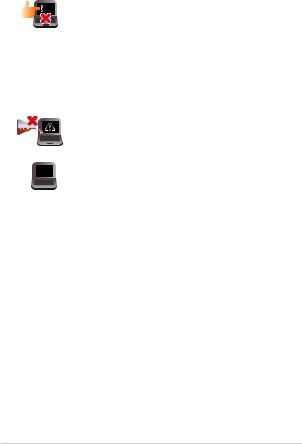
Caring for your Notebook PC
Disconnect the AC power and remove the battery pack (if applicable) before cleaning your Notebook PC. Use a clean cellulose sponge or chamois cloth dampened with a solution of nonabrasive detergent and a few drops of warm water. Remove any extra moisture from your Notebook PC using a dry cloth. Keep any liquids from entering the chassis or keyboard gap to prevent short circuit or corrosion.
Do not use strong solvents such as thinners, benzene, or other chemicals on or near your Notebook PC.
Do not place objects on top of your Notebook PC.
Do not expose your Notebook PC to strong magnetic or electrical fields.
Do not use or expose your Notebook PC near liquids, rain, or moisture.
Do not expose your Notebook PC to dusty environments.
Do not use your Notebook PC near gas leaks.
Do not place active electronic devices close to your Notebook PC to avoid electromagnetic wave interference to the display panel.
10 |
Notebook PC E-Manual |

Proper disposal
Do not throw your Notebook PC in municipal waste. This product has been designed to enable proper reuse of parts and recycling. The symbol of the crossed out wheeled bin indicates that the product (electrical, electronic equipment and mercurycontaining button cell battery) should not be placed in municipal waste. Check local regulations for disposal of electronic products.
Do not throw the battery in municipal waste. The symbol of the crossed out wheeled bin indicates that the battery should not be placed in municipal waste.
Notebook PC E-Manual |
11 |

Battery safety information
Battery protection
•Frequently charging a battery under high voltage may shorten the battery life. To protect the battery, once the battery is fully charged, the system may stop charging when the battery power is between 90% and 100%.
NOTE: The initiate battery power charging capacity is usually set between 90% and 99%. Actual value may vary by models.
•Charging or storing a battery in high ambient temperatures may result in permanent damage to the battery power capacity and rapidly shorten battery life. If the battery temperature is too high, the system may reduce the battery power charging capacity or even stop charging to protect the battery.
•Battery power capacity may drop even when your device is powered off and disconnected from the AC power. This is normal as the system still draws a small amount of power from the battery.
12 |
Notebook PC E-Manual |

Standard battery care
•If you are not using your device for a long period of time, ensure to charge the battery power to 50% then power off your device and disconnect the AC power adapter. Recharge the battery power to 50% every three months to avoid over-discharging and prevent damage to the battery.
•Avoid charging the battery at high voltage for a prolonged period of time to extend the battery life. If you are constantly using AC power for your device, ensure to discharge the battery power
to 50% at least once every two weeks. You can also adjust the settings from Battery Health Charging in MyASUS to help extend the battery life.
•It is recommended to store your battery at temperatures between 5°C (41°F) and 35°C (95°F) with the battery power at 50%. You can also adjust the settings from Battery Health Charging in MyASUS to help extend the battery life.
•Do not leave your battery in damp environments. Exposure to damp environments may increase the battery over-discharging rate. Low temperature environment may damage the chemicals inside the battery while high temperature or overheating may result in a risk of explosion.
•Do not place your device or battery pack near radiators, fireplaces, furnaces, heaters, or any sources of heat with temperature exceeding 60°C (140°F). High temperature surrounding environment may result in an explosion or leakage that may cause fire.
Notebook PC E-Manual |
13 |
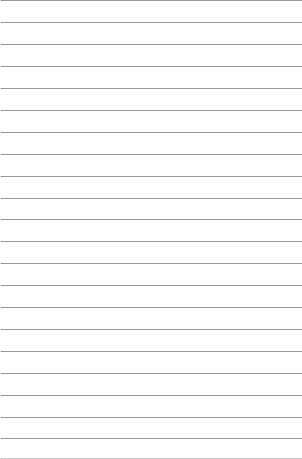
14 |
Notebook PC E-Manual |

Chapter 1:
Hardware Setup
Notebook PC E-Manual |
15 |
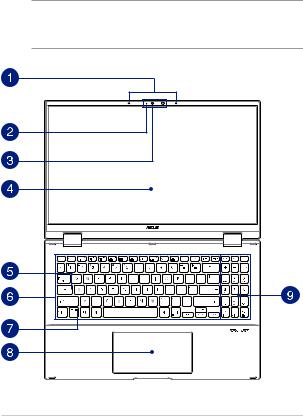
Getting to know your Notebook PC
Top View
NOTE: The keyboard's layout may vary per region or country. The Notebook view may also vary in appearance depending on the Notebook PC model.
16 |
Notebook PC E-Manual |

Array microphones
The array microphones feature echo canceling, noise suppression, and beam forming functions for better voice recognition and audio recording.
Camera indicator
The camera indicator lights up when the built-in camera is in use.
Camera
The built-in camera allows you to take pictures or record videos using your Notebook PC.
IR Camera
The built-in camera allows you to take pictures or record videos using your Notebook PC. The IR Camera also supports Windows Hello.
NOTE: The red IR LED blinks in the process while data is being read before you sign in with Windows Hello facial recognition.
Notebook PC E-Manual |
17 |

360º-adjustable touch screen panel
Your Notebook PC’s touch screen panel can be adjusted all the way into a 360º angle. This feature allows you to quickly turn your device from a Notebook PC into a touch-enabled tablet PC.
This high-definition touch screen panel provides excellent viewing features for photos, videos, and other multimedia files on your Notebook PC. It also allows you to operate it using touch screen gestures.
NOTE: For more details on how to turn your Notebook PC into a tablet device, refer to the Rotating the display panel section in this manual.
Capital lock indicator
This indicator lights up when the capital lock function is activated. Using capital lock allows you to type capitalized letters (such as A, B, C) using your Notebook PC’s keyboard.
Keyboard
The keyboard provides full-sized QWERTY keys with a comfortable travel depth for typing. It also enables you to use the function keys, allows quick access to Windows®, and controls other multimedia functions.
NOTE: The keyboard layout differs by model or territory.
18 |
Notebook PC E-Manual |
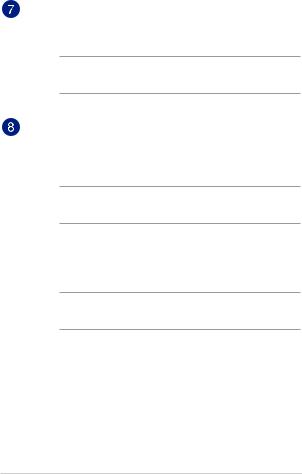
Function key lock indicator
This indicator lights up when the function keys feature is activated.
NOTE: For more details, refer to the Using the keyboard section in this manual.
Touchpad
The touchpad allows the use of multi-gestures to navigate onscreen, providing an intuitive user experience. It also simulates the functions of a regular mouse.
NOTE: For more details, refer to the Using the touchpad section in this manual.
Screenpad (on selected models)
The screenpad allows you to toggle another screen for the touchpad, providing more adaptive controls.
NOTE: For more details, refer to the Using the keyboard section in this manual.
Notebook PC E-Manual |
19 |

Numeric keypad
The numeric keypad toggles between these two functions: for numeric input and as pointer direction keys.
NOTE: For more details, refer to the Using the numeric keypad section in this manual.
20 |
Notebook PC E-Manual |

Bottom View
NOTE: The bottom view may vary in appearance depending on model.
WARNING! Your Notebook PC can get warm to hot while in use or while charging the battery pack. Do not leave your Notebook PC on your lap or near any part of your body to prevent injury from heat. When working on your Notebook PC, do not place it on surfaces that can block the vents.
IMPORTANT!
•Battery time varies by usage and by the specifications for this Notebook PC. The battery pack cannot be disassembled.
•Purchase components from authorized retailers to ensure maximum compatibility and reliability. Consult an ASUS service center or authorized retailers for product service or assistance on proper disassembly or assembly of the product.
Notebook PC E-Manual |
21 |

Air vents
The air vents allow cool air to enter and warm air to exit the Notebook PC.
WARNING! Ensure that paper, books, clothing, cables, or other objects do not block any of the air vents or else overheating may occur.
Audio speakers
The built-in audio speakers allow you to hear audio straight from your Notebook PC. Audio features are software-controlled.
22 |
Notebook PC E-Manual |
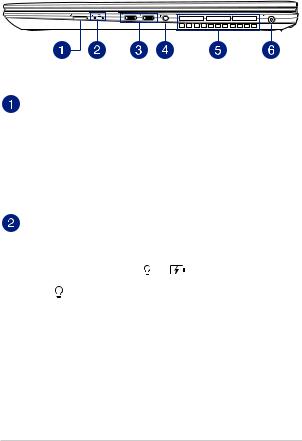
Right View
Power button
Press the power button to turn your Notebook PC on or off. You can also use the power button to put your Notebook PC to sleep or hibernate mode and wake it up from sleep or hibernate mode.
In the event that your Notebook PC becomes unresponsive, press and hold the power button for at least four (4) seconds until your Notebook PC shuts down.
Status indicators
The status indicators help identify the current hardware status of your Notebook PC.
Power indicator
The power indicator lights up when the Notebook PC is turned on and blinks slowly when the Notebook PC is in sleep mode.
Notebook PC E-Manual |
23 |

Two-color battery charge indicator
The two-color LED provides a visual indication of the battery’s charge status. Refer to the following table for details:
Color |
Status |
Solid White |
The Notebook PC is plugged to |
|
a power source and the battery |
|
power is between 95% and |
|
100%. |
Solid Orange |
The Notebook PC is plugged |
|
to a power source, charging its |
|
battery, and the battery power |
|
is less than 95%. |
Blinking Orange |
The Notebook PC is running on |
|
battery mode and the battery |
|
power is less than 10%. |
Lights off |
The Notebook PC is running on |
|
battery mode and the battery |
|
power is between 10% to 100%. |
24 |
Notebook PC E-Manual |

Thunderbolt™ 4 port
The Thunderbolt™ 4 port is compatible with USB Type-C® standards, and provides a transfer rate of up to 40 Gbit/s for Thunderbolt™ 4 devices. Connect your Notebook PC to a DisplayPort, VGA, DVI, or HDMI external display and experience high-resolution display features via Intel® Thunderbolt™ technology.
NOTE: Transfer rate of this port may vary per model.
Headphone/Headset/Microphone jack
This port allows you to connect amplified speakers or headphones. You can also use this port to connect your headset or an external microphone.
Air vents
The air vents allow cool air to enter and warm air to exit the Notebook PC.
WARNING! Ensure that paper, books, clothing, cables, or other objects do not block any of the air vents or else overheating may occur.
Notebook PC E-Manual |
25 |
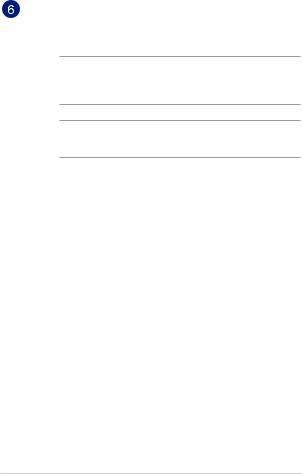
Power (DC) input port
Insert the bundled power adapter into this port to charge the battery pack and supply power to your Notebook PC.
WARNING! The adapter may become warm to hot while in use. Do not cover the adapter and keep it away from your body while it is connected to a power source.
IMPORTANT! Use only the bundled power adapter to charge the battery pack and supply power to your Notebook PC.
26 |
Notebook PC E-Manual |
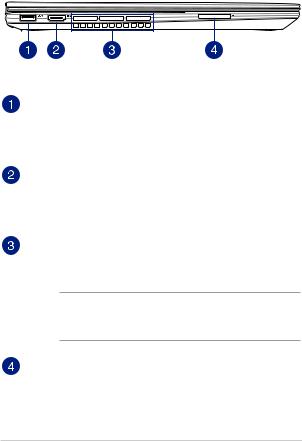
Left View
USB 3.2 Gen 1 port
The USB 3.2 (Universal Serial Bus 3.2) Gen 1 port provides a transfer rate of up to 5 Gbit/s and is backward compatible to USB 2.0.
HDMI output port
This port allows you to connect your Notebook PC to another HDMI-compatible device for file sharing or extending your display monitor.
Air vents
The air vents allow cool air to enter and warm air to exit the Notebook PC.
WARNING! Ensure that paper, books, clothing, cables, or other objects do not block any of the air vents or else overheating may occur.
Memory card reader
This built-in memory card reader supports SD card formats.
Notebook PC E-Manual |
27 |

ASUS Pen (on selected models)
Right-click button
You can use this button to enable the right-click function.
Eraser button
You can use this button to enable the eraser function.
Inserting the battery
1.Remove the top half of the stylus.
2.Remove the sticker and insert the battery, noting the correct polarity.
3.Return the top half of the stylus into place.
|
|
|
|
|
|
|
|
|
|
|
|
|
|
|
28 |
|
Notebook PC E-Manual |
||

Chapter 2:
Using your Notebook PC
Notebook PC E-Manual |
29 |

Getting started
Charge your Notebook PC
A.Connect the AC power cord to the AC/DC adapter.
B.Connect the DC power connector into your Notebook PC’s power (DC) input port.
C.Plug the AC power adapter into a 100V~240V power source.
Charge the Notebook PC for 3 hours before using it in battery mode for the first time.
NOTE: The power adapter may vary in appearance, depending on models and your region.
IMPORTANT!
Power adapter information:
•Input voltage: 100-240Vac
•Input frequency: 50-60Hz
•Rating output current: 6A (120W)
•Rating output voltage: 20V
30 |
Notebook PC E-Manual |
